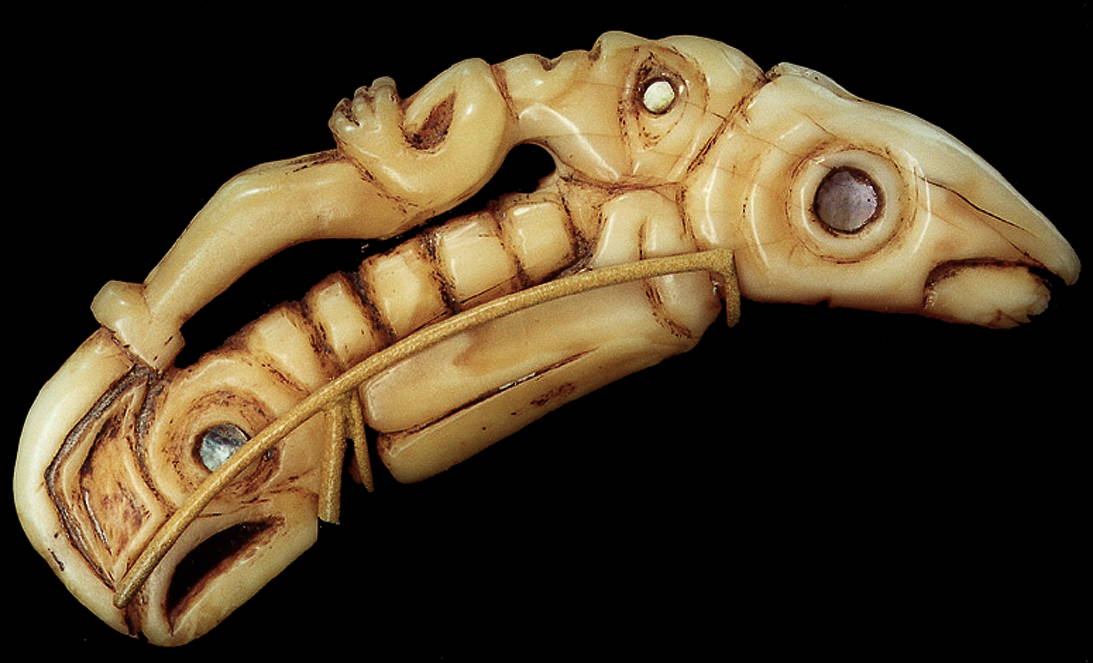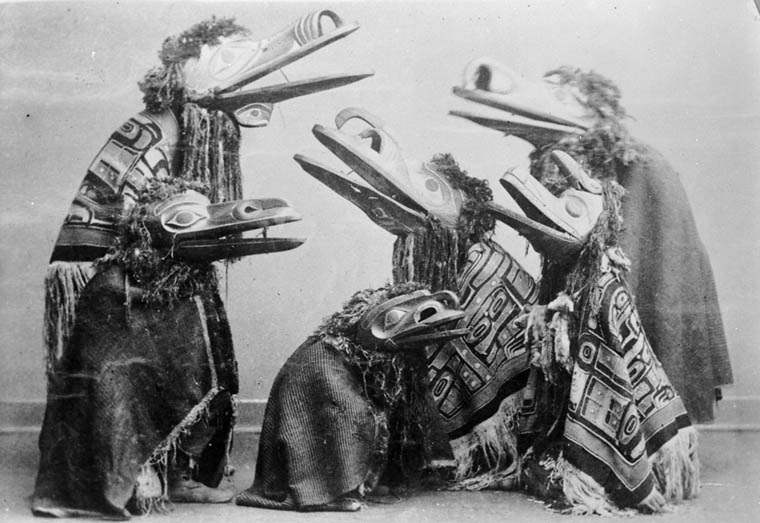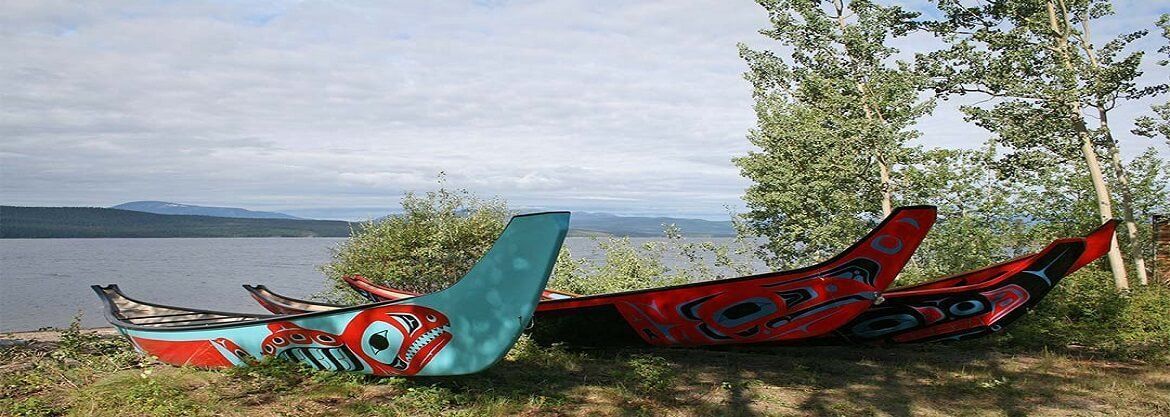Marriage
Traditionally intermarriage of moieties was not allowed. Ravens had to marry Eagles and vis versa, but today it is common for inter-clan, and inter-racial marriages to occur. Family crests There are several crests (subclans) within each moiety. The crest is what really begins to distinguish a Tlingit's family association and lineage. The crests are specific to the moiety as follows (see crests under the moiety). EAGLE Killer Whale Brown Bear Thunderbird Wolf Salmon: Coho Dog Salmon |
RAVEN Frog Sea Tern (Seagull) Beaver Salmon: Coho Dog Sa |

Tlingit Indian Shamans & Their Shaman Soul Catcher Talisman Tools..
I've been interested in the Tlingit Shamans for some time now on my soul journey it was ever since I acquired my own Tlingit Indian hand carved Walrus Ivory Shaman Soul Catcher you can see the images of it attached below..but what attracted me to them moreso was their deep connection to their Raven moiety ..continue reading to learn all about this deep connection they hold to Raven & their culture & arts...
Images by: - © √ℓἇ∂ἇ
These are Tlingit Indian Shaman Ivory or Bone Soul Catchers
Carried by a shaman when he pursued the soul of an ailing patient under his care. usually at twilight. The soul fluttered toward the horizon. With the stopper removed from his magic box, the shaman followed it, beguiling it with incantations. When he succeeded in approaching it, he popped it into the box, replaced the stopper, and returned it to the patient, who then recovered.





 http://playgroundofthesenses.com: "/>
http://playgroundofthesenses.com: "/>

A Tlingit is born with a specific and permanent identity constructed in the following order of importance: clan, moiety, house and tribe. There is heavy emphasis upon family and lineage. Tlingits are a matrilineal society and the social structure and relationships are products of the belief that all Tlingits are reincarnates of their ancestors.
Clan
This is the active and principle organization of the Tlingit societal structure. It dictates the law, life and religion of the Tlingit. Being a part of a clan is the most binding union of your existence as a Tlingit, and it is unchangeable unless you are banished. By in large a person's individualism disappears when a member of a clan because each person must defend the clan in it honor and property at any cost to their person.
Each clan stayed fairly separate and was governed by their own chief and his council. In case of attack each clan's leadership within a tribe would come together and fight as one.
Moiety (phratral crests)
Moieties are the two equal subdivisions within a clan. They distinguish an imaginary relationship that primarily functioned to organize possible bonds for marriage. The moiety within a clan did not have their own leadership. When born, the Tlingit baby assumed the moiety of their mother--either of the Eagle or Raven moiety.
Moiety (clan)
Houses
The places of residence for families and more commonly large extended families are also extensions of clans. These houses were often called long houses. They are a further way in which Tlingit people distinguish themselves.
Some examples of houses include the Snail House, Brown Bear Den House, Owl House, Crescent Moon House, Coho House, and Thunderbird House or mine, which is the Killer Whale Chasing Seal House.
Tribe
A tribe typically consisted of two clans that came together due to location (migration) or continued intermarriage. A tribe remained intact for the benefits of mutual protection, and social and economic advantages. A single clan might be a part of a number of tribes--this encouraged peace amongst the clans and tribes.
Language
Background: The Tlingit language is a branch of the Na-Dené language family and has Ancient roots shared with the Tsimshian and possibly the Haida. It is known for its complex grammar and sound system—certain phonemes are not heard in almost any other language. Some of the grammar of the Tlingit language parallels that of the Athabaskan languages like the Navajo, but it does not share vocabulary with any other language. According to linguists, the Tlingit language may have split from the Athabaskan about 5,000 years ago.
Future: The language is highly endangered, with fewer than 140 native speakers still living, all of whom are bilingual or near-bilingual in English. Why the language must be preserved: So much of the Tlingit culture to this day is preserved through memory and oratory communication. Feverish efforts have been taking place to document the knowledge and memories of the elders, but there is only so much documentation can do. Unless youth learn the language, so much of the richness of the culture will be lost. People need to continue to speak and refer to things about the culture using the original language only so much can be translated. We cannot let this language gap continue to expand. Programs: Sealaska Heritage Institute’s language programs “Sealaska Heritage Institute (SHI) produces Native language curriculum and other education tools through its Language and Education Programs. The institute encourages students and teachers to use its online resources to perpetuate and revitalize Tlingit, Haida and Tsimshian languages.” SHI also offers many opportunities to connect people to classes and programs to learn the language. Stanford Special Language Program This is a new program at Stanford that allow for students (2+) to take a class through a distance learning medium. This enables students to learn unique languages beyond the confines of what is offered at the University. Stanford students and students elsewhere could begin to be able to elect to fulfill their language requirements through this outreach medium and dying languages, such as the Tlingit language, could be better preserved. |


/cloudfront-us-east-1.images.arcpublishing.com/gray/FTXR5CYZPBINNIS2JJS6LAOQ7A.jpg)
Replies to This Discussion
-
How interesting Vlada, it is the fist time I read and learn about the Tlingits and their Culture. Fascinating!
-
-
Yes it is Interesting & fascinating,I'm glad you like it...mind you as you know me well and being Shamanic in Nature.. I've always been into different tribal cultures & anything that infuses Raven into it..
-
-
:o) Yes :o)
-
© 2025 Created by Tara.
Powered by
![]()